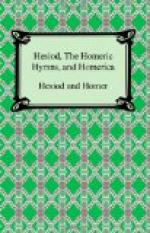an encyclopaedia of
miscellaneous topics in the form of a
dialogue. His date is c. 230 A.D.
(52) There is a fancied connection between LAAS (`stone’) and
LAOS (`people’). The reference is to the stones which
Deucalion and Pyrrha transformed into men and women after
the Flood.
(53) Eustathius identifies Ileus with Oileus, father of Aias.
Here again is fanciful etymology, ILEUS being similar to
ILEOS (complaisant, gracious).
(54) Imitated by Vergil, “Aeneid” vii. 808, describing Camilla.
(55) c. 600 A.D., a lecturer and grammarian of Constantinople.
(56) Priest of Apollo, and, according to Homer, discoverer of
wine. Maronea in Thrace is said to have been called after
him.
(57) The crow was originally white, but was turned black by
Apollo in his anger at the news brought by the bird.
(58) A philosopher of Athens under Hadrian and Antonius. He
became a Christian and wrote a defence of the Christians
addressed to Antoninus Pius.
(59) Zeus slew Asclepus (fr. 90) because of his success as a
healer, and Apollo in revenge killed the Cyclopes (fr. 64).
In punishment Apollo was forced to serve Admetus as
herdsman. (Cp. Euripides, “Alcestis”, 1-8)
(60) For Cyrene and Aristaeus, cp. Vergil, “Georgics”, iv. 315
ff.
(61) A writer on mythology of uncertain date.
(62) In Epirus. The oracle was first consulted by Deucalion and
Pyrrha after the Flood. Later writers say that the god
responded in the rustling of leaves in the oaks for which
the place was famous.
(63) The fragment is part of a leaf from a papyrus book of the
4th century A.D.
(64) According to Homer and later writers Meleager wasted away
when his mother Althea burned the brand on which his life
depended, because he had slain her brothers in the dispute
for the hide of the Calydonian boar. (Cp. Bacchylides,
“Ode” v. 136 ff.)
(65) The fragment probably belongs to the “Catalogues” proper
rather than to the Eoiae; but, as its position is uncertain,
it may conveniently be associated with Frags. 99A and the
“Shield of Heracles”.
(66) Most of the smaller restorations appear in the original
publication, but the larger are new: these last are highly
conjectual, there being no definite clue to the general
sense.
(67) Alcmaon (who took part in the second of the two heroic
Theban expeditions) is perhaps mentioned only incidentally
as the son of Amphiaraus, who seems to be clearly indicated
in ll. 7-8, and whose story occupies ll. 5-10. At l. 11 the
subject changes and Electryon is introduced as father of
Alcmena.
(68) The association of ll. 1-16 with ll. 17-24 is presumed from
the apparent mention of Erichthonius in l. 19. A new
section must then begin at l. 21. See “Ox. Pap.” pt. xi. p.
55 (and for restoration of ll. 5-16, ib. p. 53). ll. 19-20
are restored by the Translator.
dialogue. His date is c. 230 A.D.
(52) There is a fancied connection between LAAS (`stone’) and
LAOS (`people’). The reference is to the stones which
Deucalion and Pyrrha transformed into men and women after
the Flood.
(53) Eustathius identifies Ileus with Oileus, father of Aias.
Here again is fanciful etymology, ILEUS being similar to
ILEOS (complaisant, gracious).
(54) Imitated by Vergil, “Aeneid” vii. 808, describing Camilla.
(55) c. 600 A.D., a lecturer and grammarian of Constantinople.
(56) Priest of Apollo, and, according to Homer, discoverer of
wine. Maronea in Thrace is said to have been called after
him.
(57) The crow was originally white, but was turned black by
Apollo in his anger at the news brought by the bird.
(58) A philosopher of Athens under Hadrian and Antonius. He
became a Christian and wrote a defence of the Christians
addressed to Antoninus Pius.
(59) Zeus slew Asclepus (fr. 90) because of his success as a
healer, and Apollo in revenge killed the Cyclopes (fr. 64).
In punishment Apollo was forced to serve Admetus as
herdsman. (Cp. Euripides, “Alcestis”, 1-8)
(60) For Cyrene and Aristaeus, cp. Vergil, “Georgics”, iv. 315
ff.
(61) A writer on mythology of uncertain date.
(62) In Epirus. The oracle was first consulted by Deucalion and
Pyrrha after the Flood. Later writers say that the god
responded in the rustling of leaves in the oaks for which
the place was famous.
(63) The fragment is part of a leaf from a papyrus book of the
4th century A.D.
(64) According to Homer and later writers Meleager wasted away
when his mother Althea burned the brand on which his life
depended, because he had slain her brothers in the dispute
for the hide of the Calydonian boar. (Cp. Bacchylides,
“Ode” v. 136 ff.)
(65) The fragment probably belongs to the “Catalogues” proper
rather than to the Eoiae; but, as its position is uncertain,
it may conveniently be associated with Frags. 99A and the
“Shield of Heracles”.
(66) Most of the smaller restorations appear in the original
publication, but the larger are new: these last are highly
conjectual, there being no definite clue to the general
sense.
(67) Alcmaon (who took part in the second of the two heroic
Theban expeditions) is perhaps mentioned only incidentally
as the son of Amphiaraus, who seems to be clearly indicated
in ll. 7-8, and whose story occupies ll. 5-10. At l. 11 the
subject changes and Electryon is introduced as father of
Alcmena.
(68) The association of ll. 1-16 with ll. 17-24 is presumed from
the apparent mention of Erichthonius in l. 19. A new
section must then begin at l. 21. See “Ox. Pap.” pt. xi. p.
55 (and for restoration of ll. 5-16, ib. p. 53). ll. 19-20
are restored by the Translator.




